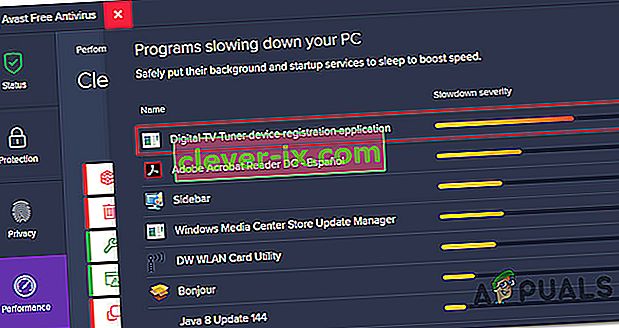De meeste populaire applicaties hebben een veilige modus waarmee gebruikers het programma met beperkte functionaliteit kunnen uitvoeren wanneer dingen niet naar behoren werken. Dat is het geval met Outlook - een complexe e-mailmanager die de Veilige modus gebruikt om veel problemen te omzeilen die verhinderen dat Outlook opstart. Mogelijk start u Outlook expres in de veilige modus, maar het kan ook vanzelf in deze modus starten.

Tenzij u om welke reden dan ook de Veilige modus zelf hebt gestart , zal ik u niet adviseren om Outlook in deze modus te blijven gebruiken. U kunt geen sjablonen en voorkeuren opslaan en u kunt onder andere geen infolabels gebruiken. Als u zich in dit soort situaties bevindt, is het raadzaam de Veilige modus als een diagnostisch hulpmiddel te behandelen en uw probleem op te lossen.
Wanneer wordt de veilige modus gebruikt in OutLook
Outlook zal het systeemregister regelmatig bijwerken om ervoor te zorgen dat de nieuwe extensies die u installeert naar behoren werken. Als het programma bij het opstarten een probleem detecteert waardoor het niet kan worden uitgevoerd, schakelt het automatisch over naar de Veilige modus . Dit gebeurt meestal direct nadat u een nieuwe add-on hebt geïnstalleerd die niet goed werkt met uw Outlook-versie.
U kunt de veilige modus zelf activeren door een venster Uitvoeren te openen en Outlook / safe te typen en op OK te drukken .

In het geval dat Outlook automatisch start in de veilige modus , is dit meestal een teken dat iets niet goed werkt. Soms lukt het Outlook om de invoegtoepassing te lokaliseren die verhindert dat Outlook normaal start. Als het u vraagt om het defecte onderdeel uit te schakelen, probeer het dan eens en kijk of Outlook erin slaagt normaal te starten.

Potentiële veilige modus-triggers
Als u versie 2010 gebruikt, wordt uw probleem waarschijnlijk veroorzaakt door de KB3114409-update die ervoor zorgt dat Outlook in de veilige modus start en terugkeert naar de standaardinstellingen. In het geval dat u een oudere Outlook-versie zoals 2007 of 2003 gebruikt, heeft uw probleem mogelijk te maken met de Windows Search- service. De verkeerde invoegtoepassing kan ook conflicteren met uw Outlook-versie tot het punt waarop u deze gedwongen start in de veilige modus .
Dit zijn slechts drie van de mogelijke boosdoeners, maar de oorzaken kunnen op veel plaatsen liggen.
Hieronder vindt u een verzameling fixes die al veel gebruikers hebben geholpen om te voorkomen dat Outlook in de veilige modus wordt uitgevoerd . Volg de bovenstaande methoden in volgorde van uw Outlook-versie totdat u een oplossing vindt die uw probleem oplost.
Methode 1: Invoegtoepassingen uitschakelen in de veilige modus (alle Outlook-versies)
Dit komt vaak voor in elke Outlook-versie van Outlook 2007 tot Outlook 2016 . Dit gebeurt omdat bepaalde invoegtoepassingen conflicteren met uw Outlook-versie. Dit is zelfs nog waarschijnlijker met verouderde invoegtoepassingen die zijn geïnstalleerd in de nieuwste versies van Outlook.
Opmerking: als u de ABBYY FineReader- invoegtoepassing hebt geïnstalleerd voordat deze fout zich voordeed, volgt u de onderstaande stappen om de invoegtoepassing uit uw Outlook-versie te verwijderen.
- Bevestig dat Outlook zich in de veilige modus bevindt door te controleren of het pictogram in uw taakbalk een uitroepteken heeft.

Opmerking: u kunt ook bevestigen door te kijken of u (Veilige modus) in het bovenste gedeelte van het scherm ziet.
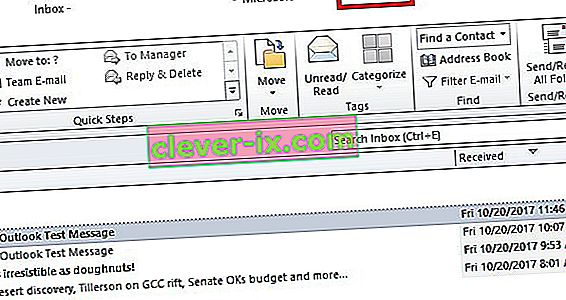
- Vouw nu het tabblad Bestand uit en klik op Opties .

- Klik nu op het tabblad Add-ins . Van daaruit opent u het vervolgkeuzemenu naast Beheren en selecteert u COM-invoegtoepassingen in de lijst. Klik op Go om verder te gaan.
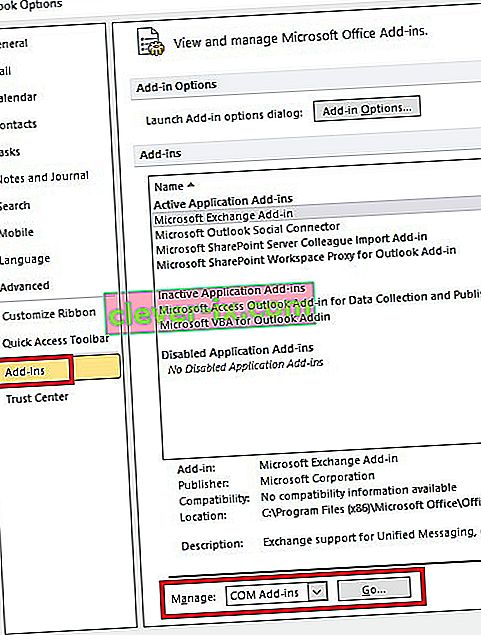
- Op dit punt moet u een screenshot maken van de add-in-lijst en deze op een geschikte plaats opslaan. Dit zal u helpen om de normale configuratie van uw Outlook te herstellen als er storingen optreden nadat u de invoegtoepassingen hebt uitgeschakeld.
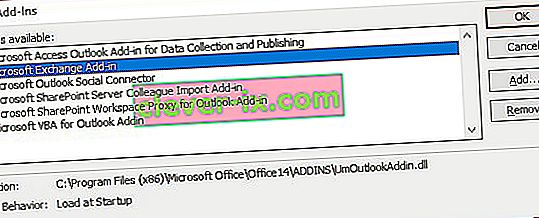
- Schakel elk item uit (verwijder geselecteerde selectievakjes) en druk op OK .
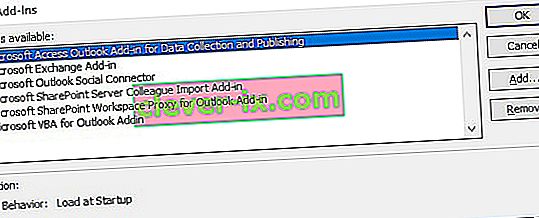 Opmerking: klik nog niet op Verwijderen . We moeten eerst bevestigen dat ze het probleem veroorzaken.
Opmerking: klik nog niet op Verwijderen . We moeten eerst bevestigen dat ze het probleem veroorzaken. - Sluit Outlook en open het opnieuw. Als het programma opstart in de normale modus, is uw probleem opgelost.
Opmerking: in het geval dat het nog steeds start in de veilige modus , ga naar Bestandsopties> Invoegtoepassingen en schakel de invoegtoepassingen die we in stap 5 hebben uitgeschakeld opnieuw in en ga naar Methode 2 .
- Keer terug naar Bestand> Optie> Invoegtoepassingen en schakel systematisch elke invoegtoepassing één voor één opnieuw in totdat u degene onthult die de conflicten veroorzaakt.
- Selecteer het en klik op Verwijderen .
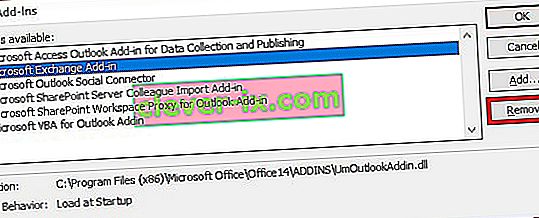
- Start Outlook opnieuw en kijk of het opstart in de normale modus.
Methode 2: Herstel uw computer met Systeemherstel (alle Outlook-versies)
Systeemherstel is een Windows-functie waarmee gebruikers hun computerstatus kunnen herstellen naar een eerder tijdstip. Dit dient ons doel als we kunnen terugkeren naar een staat waarin Outlook begon te storen. Hier is wat je moet doen:
- Houd de Windows-toets en de Press R. Type rstrui.exe en klik op OK .
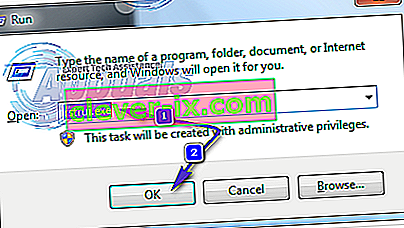
- Selecteer in het venster Systeemherstel Kies een ander herstelpunt en klik op Volgende.
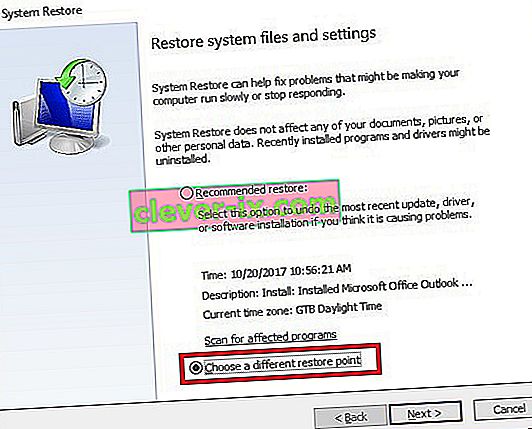
- Maak het vakje naast Toon meer herstelpunten dik .
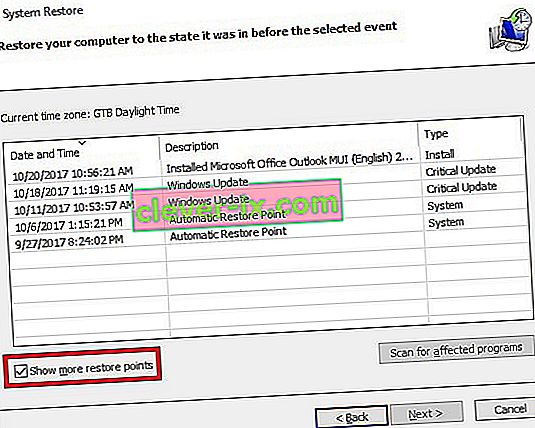
- Zoek een punt waarop Outlook werkte, kies dat herstelpunt en ga verder met de instructies op het scherm om de computer naar een eerder tijdstip te herstellen.
- Zodra dit is gebeurd, begint het systeem met herstellen. Nadat het herstel is voltooid, controleert u of Outlook werkt. als dit niet het geval is, gaat u verder met methode 3 .
Methode 3: Herstel naar een eerdere versie van Outlook
Als het herstellen van uw desktop-besturingssysteem naar een eerdere versie niet werkte, kunnen we proberen Outlook te herstellen naar een eerdere versie. Hier is hoe:
- Klik op Start en typ Outlook.exe in het zoekvenster. Klik er met de rechtermuisknop op en kies Eigenschappen .
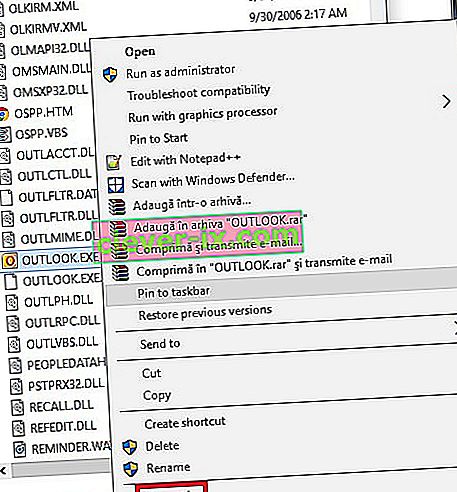
- Ga vervolgens naar het tabblad Vorige versies en zoek het bestand Outlook.exe met een datum waarop het werkte. Klik op Openen om te zien of het werkt en wordt geopend zonder Veilige modus .
 Opmerking: zorg ervoor dat de niet-werkende Outlook die eerder in Veilige modus werd geopend, is gesloten, omdat we nu een van de kopieën uitvoeren die zijn opgeslagen in de vorige versies. Doe hetzelfde voor alle versies die daar worden vermeld. Open / sluit totdat u degene ziet die wordt geopend zonder Veilige modus. Als het werkt, houd het raam dan open.
Opmerking: zorg ervoor dat de niet-werkende Outlook die eerder in Veilige modus werd geopend, is gesloten, omdat we nu een van de kopieën uitvoeren die zijn opgeslagen in de vorige versies. Doe hetzelfde voor alle versies die daar worden vermeld. Open / sluit totdat u degene ziet die wordt geopend zonder Veilige modus. Als het werkt, houd het raam dan open. - Ervan uitgaande dat u nu de versie van Outlook draait, zonder Veilige modus van een van de vorige versies. Houd de Windows-toets en Druk op R . Typ taskmgr en klik op OK .
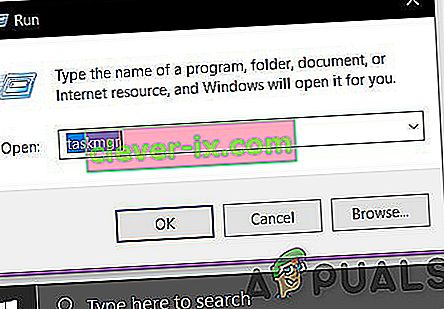
- In de Task Manager Window, Ga naar de Process Tab, lokaliseren Outlook.exe , klik met de rechtermuisknop aan en kies Open File Location.

- Kopieer alle bestanden uit het volgende venster en navigeer naar C: \ Program Files (x86) \ Microsoft Office \ Office. Plak hier het eerder gekopieerde bestand.
- Probeer Outlook opnieuw te openen en kijk of het in de normale modus start.
Methode 4: de KB3114409-update verwijderen (Outlook 2010)
Ergens in 2015 heeft Microsoft een beveiligingspatch uitgegeven waardoor Outlook in de veilige modus werd uitgevoerd en teruggezet naar de standaardconfiguratie. De door de gebruiker gemaakte configuraties gaan niet voor altijd verloren en komen terug wanneer Outlook erin slaagt op te starten in de normale modus.
Als u dit probleem heeft, zijn er twee manieren om verder te gaan. Aangezien Microsoft een update heeft uitgegeven die het probleem oplost dat wordt veroorzaakt door KB3114409 , kunnen we dat installeren via de slechte update. Een andere route zou zijn om de KB3114409 eenvoudigweg te verwijderen .
We raden u ten zeerste aan om de officiële Microsoft-updatefix te installeren. Maar voor welke optie u ook kiest, wij begeleiden u door het hele proces.
Met behulp van de officiële Microsoft-fix
Microsoft-update KB3114560 is speciaal uitgegeven om de schade te herstellen die is aangericht door KB3114409. Als vuistregel moet u altijd beveiligingsupdates installeren vanaf de officiële website. Hier is wat je moet doen:
- Ga naar deze officiële link en klik op een van de twee verschillende updateversies, volgens de specificaties van uw pc.
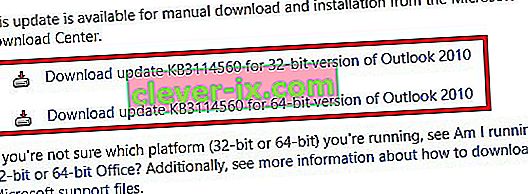
- Selecteer de standaardtaal van uw Outlook-programma en klik op de knop Downloaden .
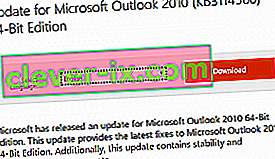
- Nadat de update is gedownload, opent u het uitvoerbare bestand en gaat u verder met het installatieproces.

- Restart your PC, open Outlook again and see if the issue has been resolved.
Uninstalling the KB3114409 update
- Close Outlook completely.
- Open Control Panel, click on Uninstall a program.
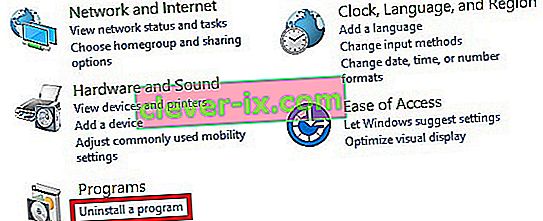
- Once you’re in the Programs and Features window, click on View installed updates.
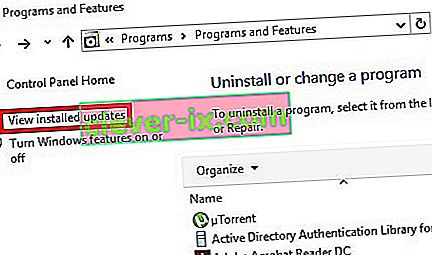
- Use the Search Installed Updates search bar in the top-right corner to search for the bad update (KB3114409 ).

- Once you manage to identify the bad update, click the Uninstall button and follow through with the confirmation prompts.

- Restart your PC, open Outlook and see if the issue repeats.
Method 5: Doing an Outlook Profile reset (All Outlook versions)
If you experience hanging at the initial Outlook splash screen (right before it initiates Safe Mode), you might need to do a profile reset. Here’s how to do it:
- Go to Control Panel > Mail and click on Show Profiles.
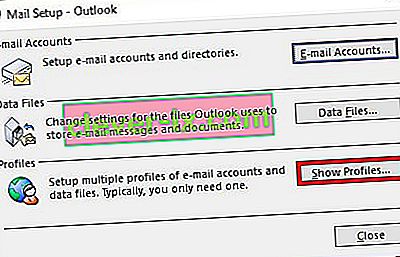
- Now, create a new profile by clicking the Add button. Insert a name and hit OK.
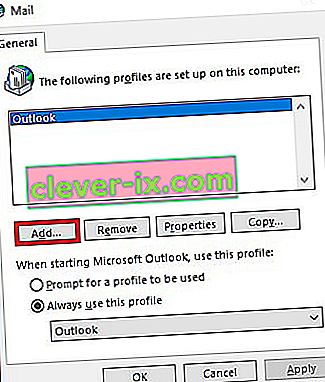
Note: Do not delete the original profile, because we don’t know if this will end up fixing the issue.
- Go through the steps of configuring your email account with Outlook. Make sure to use the same email that you have on the already created profile.
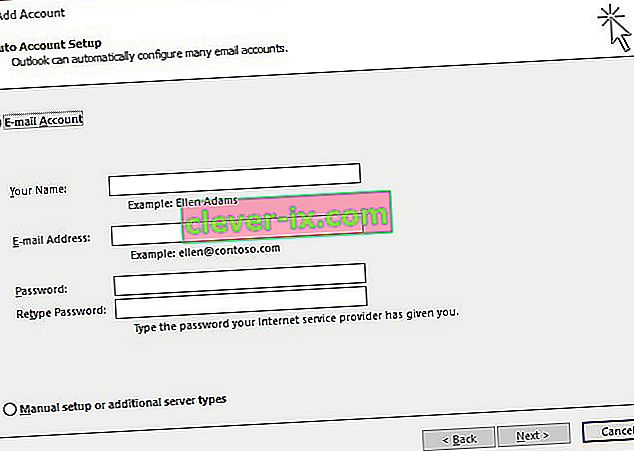
- Now return to the Mail window and make sure the profile you’ve just created is being used by default. Hit Apply to confirm your selection.

- Start Outlook again and see if it manages to start in normal mode after the profile reset.
Method 6: Checking the PST folder for corruption (All Outlook versions)
Another common cause for Outlook starting in Safe Mode is the Personal Folders File (PST). In the event that it becomes very large, or some files inside are corrupted, it might prevent the program from starting in normal mode. Luckily, you can easily check for corruption by using a Microsoft Repair tool called Scanpst.exe. Here’s what you need to do:
- Close Outlook completely and navigate to C:\ Program Files or C:\ Program Files (x86), depending on which version of Outlook you use.
- Use the search box in the top-right corner to search for SCANPST.exe.
 Note: If you don’t manage to find the SCANPST executable via the search bar, you need to navigate to the exact location. Here’s a list of the exact locations based on various Outlook versions:
Note: If you don’t manage to find the SCANPST executable via the search bar, you need to navigate to the exact location. Here’s a list of the exact locations based on various Outlook versions:2016: C:\Program Files (x86)\Microsoft Office\root\Office16 2013: C:\Program Files (x86)\Microsoft Office\Office15 2010: C:\Program Files (x86)\Microsoft Office\Office14 2007: C:\Program Files (x86)\Microsoft Office\Office12
- Open SCANPST.exe and set the path of the PST file you want to scan by using the Browse button. By default, the PST files are stored in Documents\Outlook Files. When you are ready, hit Start to begin the scan.
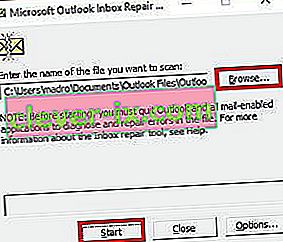
- If the scan uncovers errors or inconsistencies, click on the Repair button to fix them.
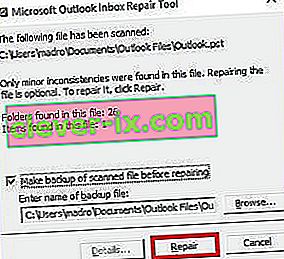
- Once the repair is done, restart Outlook with the profile that you’ve just repaired of errors and see if it starts in normal mode.
Method 7: Running the /resetnavpane command (All Outlook versions)
The navigation pane is that left portion of Outlook where you can oversee your folder list and access various icons to move between calendar, people, tasks, and mails. Sometimes, it can become glitched and prevent Outlook from starting in normal mode. Luckily, there is a command that removes any customizations to the navigation pane and gets rid of any glitch. Even better, this is done outside Outlook with ease. Here’s how:
- Close Outlook completely.
- Go to Start and access the Run application.
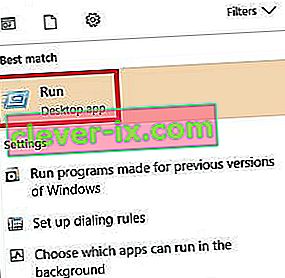
- Now, type Outlook.exe /resetnavpaneand hit OK.
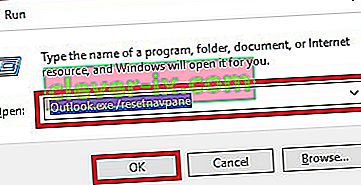 Note: Keep in mind that any customization to the navigation pane will be lost after you click on OK.
Note: Keep in mind that any customization to the navigation pane will be lost after you click on OK. - Shortly after, Outlook should automatically open in normal mode.
Method 8: Disabling compatibility mode
A lot of users have reported that they managed to start Outlook in normal mode after finding out it was running in compatibility mode. Compatibility mode is designed to help a program run as if it was running on an older operating system. As it turns out, turning off compatibility mode might just fix your Outlook Safe Mode problem. Here’s how:
- Close Outlook and navigate to the Outlook.exe on your computer. The exact path of it will differ, depending on your Outlook version. Here’s a list of the exact paths depending on your Outlook version:
2016 - C:\Program Files (x86)\Microsoft Office\root\Office16 2013 - C:\Program Files (x86)\Microsoft Office\Office 15 2010 - C:\Program Files (x86)\Microsoft Office\Office 14 2007: C:\Program Files (x86)\Microsoft Office\Office12

- Right-click on Outlook.exe and click on Properties.
- Now click on the Compatibility tab and make sure the box directly under Compatibility Mode is unchecked. Hit Apply to confirm your selection.
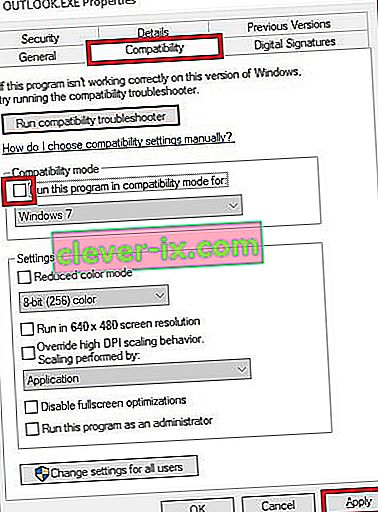
- Finally, open Outlook from the same Outlook executable and see if it manages to start in normal mode.
Method 9: Disabling hardware acceleration (All Outlook versions)
As it turns out, Outlook tries to use hardware acceleration whenever it can to make things as seamless as possible. If you’re Outlook forces itself into Safe Mode, it could very well be an issue with hardware acceleration. We can check to see if that’s the case by making some minor tweaks inside regedit. Here’s how:
- Go to Start and open the Run application.
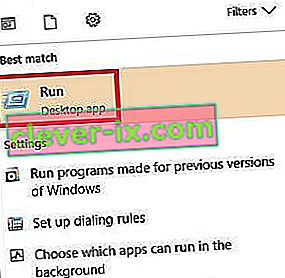
- Search for regedit and click OK to open the Registry Editor.
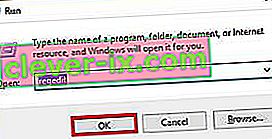
- Navigate your way to the following location
HKEY_CURRENT_USER\ Software\ Microsoft\ Office.
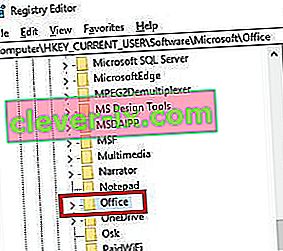
- Now, depending on which Outlook version you have, you might encounter different folders. You should either see a folder named 14.0, 16.0 or 8.0. Either way, click on the folder and double-click on the Common folder.

- Right-click anywhere in the Common folder, select New and click on Key and name it Graphics.
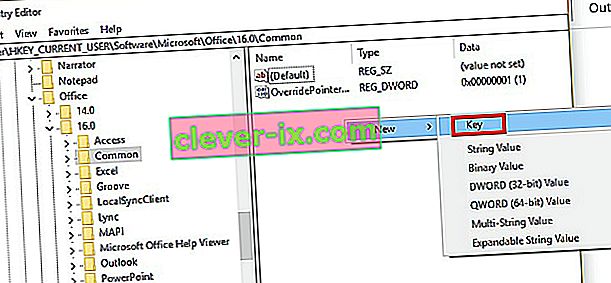
- Select the newly created Graphics folder and right-click on the right panel. From there, create a New Dword (32-bit) Value and name it DisableHardwareAcceleration.
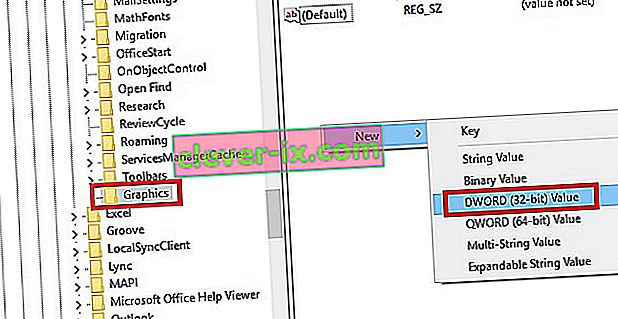
- Now double-click on DisableHardwareAcceleration and set the Value Data to 1 and hit Ok.
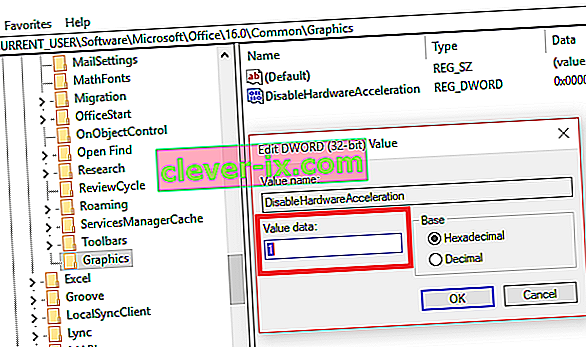
- Close regedit and open Outlook again to see if it starts in normal mode.
Method 10: Resetting the Safe Mode Registry Key (Outlook 2010)
If you have unsuccessfully followed all the methods above, there’s one more thing you can try. A final solution would be to try and prevent Safe Mode from kicking in by tweaking the registry key. But keep in mind that after you’ll follow the steps below, you won’t be able to use Safe mode in the future. At least not until you remove the key that we will create. Here’s what you need to do:
- Go to Start and open the Run application.

- Search for regedit and click OK.

- Navigate your way through HKEY_CURRENT_USER\ Software\ Microsoft\ Office.

- Now, depending on which Outlook version you have, you might encounter different folders. You should either see a folder named 14.0, 16.0 or 8.0. Either way, click on the folder navigate further to Outlook \ Security.
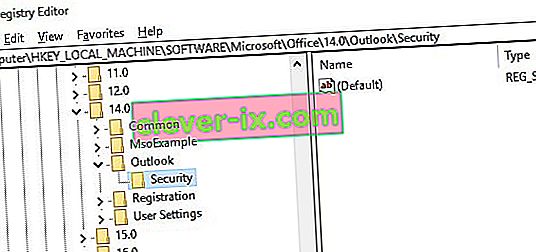 Note: If the Security folder is missing, Right-click > New > Key and type Security.
Note: If the Security folder is missing, Right-click > New > Key and type Security. - Right-click on the Security key and choose New > then DWORD (32-bit) Value.
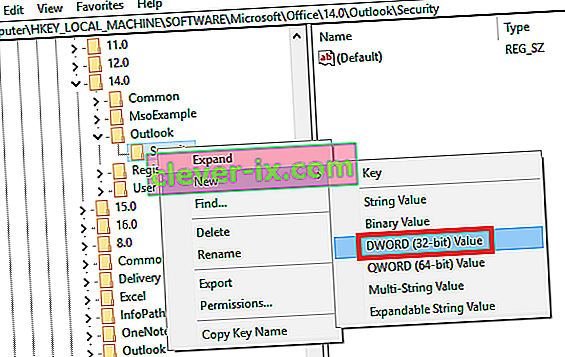
- Name it DisableSafeMode and press Enter to confirm.
- Right-click on DisableSafeMode and click on Modify.
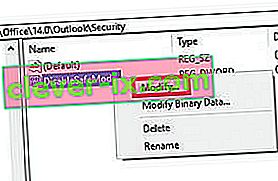
- Plaats de waarde 1 in de Waardegegevens vak en klik op OK .
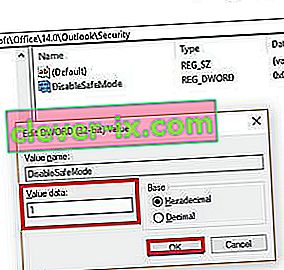
- Sluit de Register-editor af en start uw computer opnieuw op.
- Open Outlook en kijk of het opstart in de normale modus.





 Opmerking: klik nog niet op Verwijderen . We moeten eerst bevestigen dat ze het probleem veroorzaken.
Opmerking: klik nog niet op Verwijderen . We moeten eerst bevestigen dat ze het probleem veroorzaken.




 Opmerking: zorg ervoor dat de niet-werkende Outlook die eerder in Veilige modus werd geopend, is gesloten, omdat we nu een van de kopieën uitvoeren die zijn opgeslagen in de vorige versies. Doe hetzelfde voor alle versies die daar worden vermeld. Open / sluit totdat u degene ziet die wordt geopend zonder Veilige modus. Als het werkt, houd het raam dan open.
Opmerking: zorg ervoor dat de niet-werkende Outlook die eerder in Veilige modus werd geopend, is gesloten, omdat we nu een van de kopieën uitvoeren die zijn opgeslagen in de vorige versies. Doe hetzelfde voor alle versies die daar worden vermeld. Open / sluit totdat u degene ziet die wordt geopend zonder Veilige modus. Als het werkt, houd het raam dan open.












 Note: If you don’t manage to find the SCANPST executable via the search bar, you need to navigate to the exact location. Here’s a list of the exact locations based on various Outlook versions:
Note: If you don’t manage to find the SCANPST executable via the search bar, you need to navigate to the exact location. Here’s a list of the exact locations based on various Outlook versions:


 Note: Keep in mind that any customization to the navigation pane will be lost after you click on OK.
Note: Keep in mind that any customization to the navigation pane will be lost after you click on OK.








 Note: If the Security folder is missing, Right-click > New > Key and type Security.
Note: If the Security folder is missing, Right-click > New > Key and type Security.



